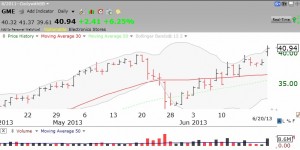A good way to find winners is to look at stocks that can go up when the market is in a steep decline. I happened to find GME, which broke out of a cup and handle base on above average volume on Thursday. See this article about the GME advance on Thursday. This stock is probably worth watching to see if the break-out can hold. I do not like to go long, however, when the market indexes are weakening.
The market is getting very over-sold. Three of the 4 oversold indicators I watch are negative. The put/call ratio is at 1.29, one of the highest readings of bearish sentiment I have ever seen. The Worden T2108 is at 21%, in an area where the market could bottom. While I expect a bounce soon, another day with the GMI below 3 will cause a Sell signal to be issued.

Would you please provide a quick update on the status of the current QQQ short term trend? Thanks.
Any way you can enable this blog to be more interactive where readers can paste their charts on the comment section. But, in the mean time yest, the market is oversold to an extent. Alhough, the bounce will dictate market direction for the next 12 months. If bounce fails to make a new high, deeper correction will be anticipated. Time will tell. I would be scaling out of triple leveraged ETFs (ie SQQQ etc). Although, the indicators on the longer term charts looks bullish for this 3X etfs. But as I said, time will tell.
Here are some interesting statistics I came up with using ETFreplay.com. Assuming one had gone long as of the Feb. 28 buy signal, here are the results using different etfs, including shorting inverse etfs (to take advantage of time decay).
Long:
QQQ — Return: 5.5% / Volatility (an ETFreplay.com measure of volatility: 13.4
QLD — 10.4/26.6
TQQQ — 14.9/39.9
Short:
PSQ — (i.e., go short PSQ) 6/13.5
QID — 12.1/26.4
SQQQ — 18.1/40.1
As you can see, going shot an inverse etf provided better returns with about the same volatility. Of course, the above statistics don’t take into account borrowing costs for going short.